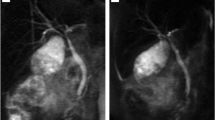Abstract
Anomalous low insertion of cystic duct (LICD) is present in 10.4% of cases. Its preoperative detection is possible with MRCP (95% accuracy). Commonly they present as post-cholecystectomy cholangitis ( Mirizzi's syndrome). Only few small case reports are available in the literature to serve as a guideline for its management. We present the management of 35 cases of LICD done by a single surgeon in the last 10-year period. Thirty four out of 35 cases were post cholecystectomy. We streamlined our surgical management depending on biliary dilatation (cut off 1 cm). Open or laparoscopic CD clearance after slitting CD vertically and obliterating the CD pouch with sutures including the common wall + / − choledocho-duodenostomy if bile duct is more than a centimetre. We did open surgery in 20 cases and laparoscopic in 15. Our follow up duration was 2 months to 3 years with a serial ultrasound and LFT yearly. No recurrence of symptom and/or stricture was noted in all cases except one case had pancreatic duct stones in ampulla that required ERCP. Our 30-day mortality was 1/35 cases (3%) due to severe CRE sepsis. LICD presenting as Mirizzi’s syndrome is a complex surgical problem. We recommend MRCP in all cases. With our surgical approach either open or laparoscopic, by obliterating the CD pouch + / − biliary bypass can cure this problem forever, but we need much larger studies to establish a care pathway for LICD.






Similar content being viewed by others
References
Womack NA, Crider RL (1947) The persistence of symptoms following cholecystectomy. Ann Surg 126(1):31–55. https://doi.org/10.1097/00000658-194707000-00004
Kao JT, Kuo CM, Chiu YC, Changchien CS, Kuo CH (2011) Congenital anomaly of low insertion of cystic duct: endoscopic retrograde cholangiopancreatography findings and clinical significance. J Clin Gastroenterol 45(7):626–629. https://doi.org/10.1097/MCG.0b013e31821bf824
Palanivelu C, Rangarajan M, Jategaonkar PA, Madankumar MV, Anand NV (2009) Laparoscopic management of remnant cystic duct calculi: a retrospective study. Ann R Coll Surg Engl 91(1):25–29. https://doi.org/10.1308/003588409X358980
Turner MA, Fulcher AS (2001) The cystic duct: normal anatomy and disease processes. Radiographics. 21(1):3–22. https://doi.org/10.1148/radiographics.21.1.g01ja093. (questionnaire 288-94)
Bodvall B, Overgaard B (1966) Cystic duct remnant after cholecystectomy: incidence studied by cholegraphy in 500 cases, and significance in 103 reoperations. Ann Surg 163(3):382–390. https://doi.org/10.1097/00000658-196603000-00009
Rozsos I, Magyaródi Z, Orbán P (1997) Cysticus csonk szindróma és a minimálisan invazív sebészet [Cystic duct syndrome and minimally invasive surgery]. Orv Hetil. 138(38):2397–401 (Hungarian)
Cuschieri A, Berci G (1992) Laparoscopic Biliary Surgery. Blackwell, Oxford, pp 96–116 (pp. 134–42)
Enns R, Brown JA, Tiwari P, Amar J (2001) Mirizzi’s syndrome after cholecystectomy. Gastrointest Endosc 53(6):629. https://doi.org/10.1067/mge.2001.114711
Bhuiya RM, Nimura Y, Kamiya J, Kondo S, Nagino M, Kanai M et al (1997) Recurrent carcinoma of cystic duct remnant with subcutaneous implantation in abdominal wall. HBP Surg 4:223–226
Shelton JH, Mallat DB (2006) Endoscopic retrograde removal of gallbladder remnant calculus. Gastrointest Endosc 64(2):272–273. https://doi.org/10.1016/j.gie.2006.01.042
Benninger J, Rabenstein T, Farnbacher M, Keppler J, Hahn EG, Schneider HT (2004) Extracorporeal shockwave lithotripsy of gallstones in cystic duct remnants and Mirizzi syndrome. Gastrointest Endosc 60(3):454–459. https://doi.org/10.1016/s0016-5107(04)01810-3
Sowula A, Groele H (1999) Mirizzi syndrome caused by the gallstone in long remnant of a cystic duct]. Wiad Lek. 52(1–2):85–8 (Polish)
Janes S, Berry L, Dijkstra B (2005) Management of post cholecystectomy Mirizzi’s syndrome. J Minim Access Surg 1(1):34–36. https://doi.org/10.4103/0972-9941.15244
Rozsos I, Magyaródi Z, Orbán P (1997) The removal of cystic duct and gallbladder remnant by microlaparotomy. Acta Chir Hung 36(1–4):297–298
Yu JJ, Morell M, Lee JG, Imagawa DK (2017) A case report on a rare anatomic variant of cystic duct insertion. J Surg Case Rep. 2017(7):rjx13. https://doi.org/10.1093/jscr/rjx131
Choi SJ, Yoon JH, Koh DH et al (2022) Low insertion of cystic duct increases risk for common bile duct stone recurrence. Surg Endosc 36:2786–2792. https://doi.org/10.1007/s00464-021-08563-2
Author information
Authors and Affiliations
Contributions
Conceptualization—Debkumar Ray.
Data curation—Kaushik, Debkumar Ray.
Formal analysis—Debkumar Ray.
Methodology—Kaushik, Debkumar Ray.
Validation—Debkumar Ray.
Writing, reviewing, and editing—Kaushik, Debkumar Ray.
Corresponding author
Ethics declarations
Conflict of Interest
The authors declare no competing interests.
Additional information
Publisher's Note
Springer Nature remains neutral with regard to jurisdictional claims in published maps and institutional affiliations.
Rights and permissions
Springer Nature or its licensor (e.g. a society or other partner) holds exclusive rights to this article under a publishing agreement with the author(s) or other rightsholder(s); author self-archiving of the accepted manuscript version of this article is solely governed by the terms of such publishing agreement and applicable law.
About this article
Cite this article
Ray, D., Bhattacharya, K. Anomalous Low Insertion of Cystic Duct Causing Obstructive Jaundice: a Diagnostic and Treatment Dilemma—Report of a Case Series and Management Protocol. Indian J Surg (2024). https://doi.org/10.1007/s12262-024-04055-4
Received:
Accepted:
Published:
DOI: https://doi.org/10.1007/s12262-024-04055-4




